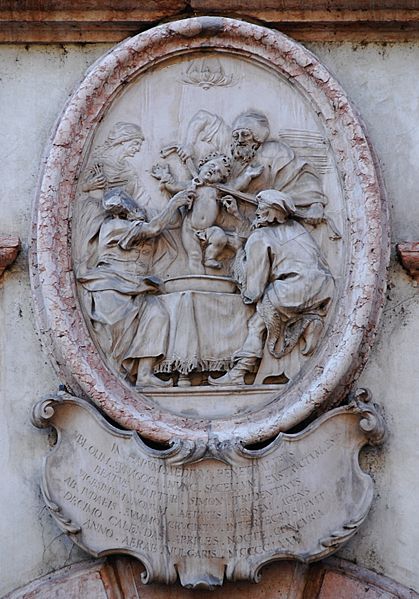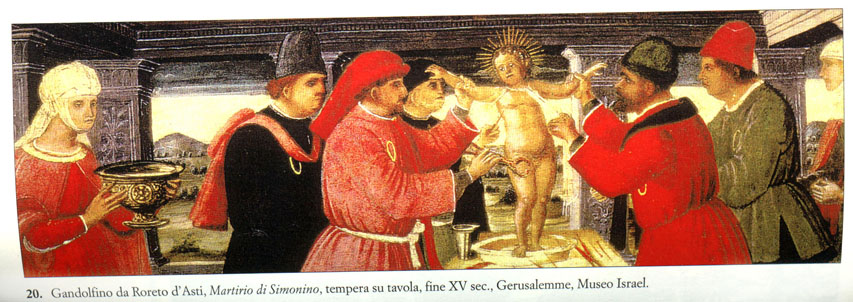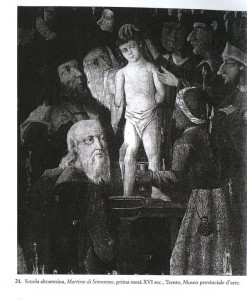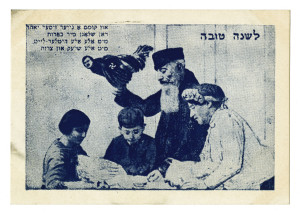Daily Stormer
June 29, 2014

The following excerpt is found in chapter 14 of the book Blood Passover. The author is the son of the Chief Rabbi of Rome, and a professor of Jewish Renaissance and Medieval History at Bar-Ilan University in Israel, just outside Tel Aviv.
Dr. Toaff was uniquely qualified to write the book, being thoroughly familiar with the derivative literature in English, French, German and Italian, as well as the original documentary sources in Latin, Medieval Italian, Hebrew and Yiddish. This is not something he worked on in secret. On the contrary, he worked on it openly with his university students and colleagues in Israel for several years; one of his students was even going to publish a paper on the subject. The author is extremely careful about what he says, and his conclusions must be taken seriously. It reads like a detective story.
If it had been published in Israel, in Hebrew, no one would have cared. There are large bodies of literature in Hebrew that Jews do not wish Gentiles to know about. But Dr. Toaff’s announcement of its publication in Italy, in Italian, raised a worldwide firestorm of fury. Under unbearable pressure, the book was withdrawn from publication, and is not to be re-issued.
The text has now been completely revised and professionally edited and released in book form by the Italian editors Gian Marco Lucchese and Pietro Gianetti. It is the only complete and correct English translation of the original unexpurgated, uncensored first edition of the Dr. Toaff’s important work, released in protest of the ADL’s destruction and suppression of it.
The full book can be purchased here and found online here.
Come in out of the darkness, and strike a blow for the light.
Read it and pass it on.

“Doing the Fig”: Obscene Rituals and Gestures (Excerpt)
The [Ashkenazi] Jews possessed a vast range and picturesque catalogue of anathemas against Jesus and the Christians, generally reinforced by appropriate gestures of mockery and contempt, often taking the form of obscene and scurrilous jests. Offensive and obscene gestures, ritualized and sanctified by the holy temple in which they were performed, constituted an effective instrument of communication, directed at their own community, to request and obtain the anticipated and complacent approval, or at least silent complicity. The insults and scurrilous gestures most frequently resorted to [by Jews] during the Middle Ages, right down to the end of the early modern age, include the rhythmic stamping of the feet to create an ear-splitting din intended to drown out any mention of the memory or even the very voice of the adversary; the act of sticking out the tongue and/or making faces, the of spitting in the face, the act of uncovering the buttocks and the gesture of “doing the fig.” The latter, considered a particularly insulting gesture of contempt, was performed by displaying the hands with the thumb tightly inserted between the index and middle fingers, a symbolic allusion to the female genital organ during the act of copulation.
When, in the weekly readings of the Pentateuch, they reached the fragment relating to the Amalek (Deut. 25: 17-19), considered Israel’s implacable enemy and persecutor par excellence throughout history, the participants in the liturgy of the synagogue stamped their feet violently, accompanied by a deafening noise to drown out any mention of their name. This often occurred during the recitation of the meghillah, the roll of Esther, during the feast of Purim, at every mention of Haman, Assuerus’s cruel minister, inventor of the plan to exterminate the Jewish people in the land of Persia. The hubbub was also renewed when at any mention of Zeresh, Haman’s faithful consort, and his numerous children, in the liturgical text. In this connection, Leon da Modena recalled that “some people, at the mention of Haman’s name, beat on the benches of the synagogue as a sign that they were cursing him,” a custom the existence of which was confirmed by the convert Giulio Morosini, who stated that, at Venice, the Jews pounded violently on the flat surfaces of their wooden benches in the synagogue as a sign of execration of the hated enemy, “pound on the benches of the synagogue with all their strength as a sign of excommunication, saying in a loud voice, ‘May his name be blotted out,’ and ‘May the name of the impious putrefy’”
One of the most widespread prayers of the Jewish ritualistic formulary was doubtlessly the one beginning with the words ’Alenu leshabbeach (“We must praise the Lord”), which was to be recited several times a day and during feasts and solemnities. This text, sometimes called a sort of “Credo of Judaism,” not surprisingly contained expressions particularly critical of Jesus and Christianity. Ecclesiastical censure therefore dealt severely with this prayer, erasing all polemical mention of the faith in Christ from the manuscripts and prohibiting any printing of the full text. Yet, nonetheless, during the persecutions of the Middle Ages, it was precisely this prayer which was most frequently shouted at their persecutors by Jews when the time case to sacrifice their lives to God.
In the tradition of the German Jews, at the phrase “So that they (the Christians) may prostrate themselves and turn their prayers to vanity and nullity, to a God which is not the Savior,” it was the custom to perform gestures of reproof and contempt, such as stamping the feet, shaking the head or jumping up and down on the ground. Giulio Morosini reported that, even in his time, when the Jews of Venice recited the liturgical hymn ’Alenu le-shabbeacuh, which he described as “contumelious against Christ and Christians […] some attest that, when saying these words, they are accustomed to show abomination by spitting.” Insulting and scurrilous gestures and obscene acts, even, and most particularly, if performed within the holy confines of the synagogue, lost their negative connotations and served to underline and stress their passionate hatred and implacable contempt.

On the Sabbath right after little Simon’s murder, when the child’s body was placed on the almemor, the Jews of Trent, gathered in the synagogue, abandoned themselves to excessive gestures absolutely without inhibition or restraint. According to the deposition of Angelo da Verona’s servant, Lazzaro, Samuele da Nuremberg, after concluding his fiery anti-Christian sermon against Jesus and His Mother, rushed up to the almemor, and, after “doing the fig”, slapped the boy in the face and spat on him. Not to be outdone, Angelo de Verona imitated these outrageous gestures, spitting and slapping the corpse, while Mosè “the Old Man” of Würzburg “did the fig”, mockingly showing his teeth, while Maestro Tobias allowed himself to be carried away in the performance of other acts of violence, with no shortage of slapping and spitting.
This scandalous spectacle was crowned by the other participants, led by Isacco, Angelo’s cook, and Mosè da Bamberg, the traveler, Lazzaro and Israel Wolfgang, the painter, and Israel, Samuele’s son, who, in addition to “doing the fig” like the others, stuck out his tongue and made faces. For their part, Joav da Ansbach, Maestro Tobias’s scullery boy, had no hesitation in performing obscene gestures, and, coarsely raising his caftan, displayed his buttocks [and genitals] shamelessly, a blasphemous act sometimes reserved solely for the passing of holy processions. Joav himself, in his confession, added that he had bitten the child’s ear in an attempt to imitate or outdo Samuele da Nuremberg. Anna da Montagana, the latter’s daughter-in-law, confirmed that she had indeed been present at this unedifying scene.
Bella, wife of Mayer, son of Mosè of Würzburg, recalled that she had been present at the exhibition of similar insulting gestures, always at Trent, three or four years earlier, on the occasion of another child murder, also committed in Samuele’s house. In this case as well, the outrageous ritual had been performed in the synagogue during the hour of prayer. For his part, Israel Wolfgang described the details of the 1467 ritual murder at Regensburg in which he claimed to have participated personally, stating that “the same insulting acts as those at Trent, in Samuele’s house,” were performed in Sayer’s stiebel [parlor] in the presence of the child’s body [as in 1467].
Giovanni Hinderbach summarized the Trent defendants’ depositions relating to the scene of the outrageous acts performed in the synagogue in a letter sent to Innsbruck in the fall of 1475, addressed to the orator of the Republic of Venice before Sigismundo, Archduke of Austria, written in a kind of Italian which was unusual for him and somewhat crude:
“The said Jews, or some of them, the said body having been placed on the almemor, said the following, or similar words, in the Hebrew language: ‘This be in contempt and shame of our enemies,’ referring to us Christians. Quite a few others ‘did the fig’ in the eyes of the corpse, while others raised their hands to heaven and stamped their feet on the ground, while others spat in the face of the said body, saying these other words: ‘Go to the God of Jesus, your God, and Mary, may she help you; pray to her to free you, and may she rescue you from our hands’ ”.
The bishop of Trent was either suffering from a memory lapse or was committing a more or less intentional error here, because the Jews could not have defied Jesus and the Madonna to come to the assistance of the poor child on that occasion. In fact, in their eyes, the boy lying on the almemor and the Crucified Christ were one and the same person. Simon did not exist – if he had ever existed – and, in his place, they saw the Talui, Jesus the hanged, and the Teluiah, the hanged or crucified woman, as Mary was called in an extemporaneous Hebraic neologism. To them, he was the Christ, and whoever had engendered Him – the detestable embodiments of Christianity, responsible for their miserable Diaspora, their bloody persecutions and forced conversions. Almost trance-like, they cursed and swore, performed contemptuous and obscene gestures, each one recalling tragic family memories and the many sufferings of those who, in their eyes, had embraced the cross as an offensive weapon.
The indignities heaped upon this innocent, sacrificed child in some ways resembled the Cabalistic rite of the kapparot (“The [Fast of] Expiation”), an established custom among German Jews on the eve of the solemn fast of Kippur. On that occasion, young white free-range roosters were whirled around the head of the sinner to assume the sinner’s transgressions. The roosters were later sacrificed, taking punishment upon themselves on behalf of the guilty-minded transgressors. This ritual was intended to bring about the symbolic transfer of a person’s sins onto an animal, which was then sacrificed, serving a similar function to that of the expiatory goat [scapegoat]. Where the cock assumed the guilt of the entire community, the rooster of the cabbalistic, magical kapparot served as a receptacle for the sins of the individual, erased through the killing of the innocent bird. The custom of the kapparot, widespread among the Ashkenazi Jews of Venice, was vividly described, as usual, by Samuele Nahmias, alias Giulio Morosini:
“All the males and females in the house go out and look for white chickens: the men look for a white rooster, while the women look for a white hen, and then they whirl these chickens around their heads several times, saying these words […] ‘This be in exchange for myself, may this take my place, this be my expiation, may this bird go to its death while I go on living.’ After the ceremony, they butcher the birds and eat them, and then they give some of the meat to some poor person, in charity, in the belief that if God had condemned any of them to death, he would now have to settle for the rooster or hen in exchange […]. They all practice this ritual, particularly in the Levant and in Germany.”
Once again, at the beginning of the 18th century, the Minorite friar Luigi Maria Benetelli severely censured those Jews of Venice, presumably belonging to the German community, who unperturbedly maintained the custom of the kapparot on the eve of the Fast of Expiation. According to him, these Jews intended to transfer the ballast of their own sins onto the white roosters, condemned to be sacrificed, while irreverently imitating the Passion of Christ:
“Many of you, on that day, dress in white and search for a white rooster without a single reddish feather (since red is the color of sin), and, clutching it by the neck and whirling it around your heads three times, pray that the rooster may expiate their sins; they torment the rooster by pulling its neck, they butcher it, throw it violently on the ground, and finally, they roast it; denoting, by means of the first torment, that they themselves deserve to be strangled; by means of the second torment, that they themselves deserve to be killed with a noose; in the third, that they themselves deserve to be stoned; and in the fourth, that they themselves deserve to be burnt for their sins. Not all (and for this reason, I said ‘many’) practice this ceremony even today. To me, it is enough that many of them, although unintentionally, admit, in fact, that the Messiah, which is white for its divinity and red for Humanity, should expiate sin.”
Similarly, as with the kapparot, in the case of the Christian child, his crucifixion transforms the child into Jesus and into Christianity, symbolically allowing the community to savor that vengeance against the enemies of Israel which is a necessary, although insufficient, preamble to their final redemption. The crescendo of insults and contemptuous gestures in front of the almemor of the synagogue was not, paradoxically, directed against the innocent boy, but rather, against Jesus, “the hanged one”, whom the boy personified. Whether by ‘doing the fig,’ spitting on the ground, grinding their teeth or stamping their feet, all the participants in the spectacular representation, alive and charged with tension, repeated the Hebrew wish, ken ikkaretu kol oyevecha, which means, “thus may our enemies be consumed.”
The women also had their role to play in the ritual of vilification, and their role was not one of secondary importance. Their enthusiastic participation in the display of verbal and gestural contempt during the functions of the synagogue was well known to everyone and caused no surprise. Rabbi Azriel Diena, in a ritual response sent to the heads of the Jewish community of Modena in the month of November 1534, censured the bad habits of the women, who, in the synagogue, as well as on the Sabbath and during the festivities, “when the solemn moment arrives in which the rolls of the Torah were extracted from the Ark, they rise up, as if they were infuriated, launching a barrage of insults and curses against all those whom they hated.” Beniamin Slonik, rabbi of Grodno in the Grand Duchy of Lithuania, in his manual of honest female behavior in the Ashkenazi communities, which was translated into Italian several times, attempted, in an effort to teach them to restrain themselves and cool their burning ardor, to explain the predisposition of Jewish women to imprecate and fling endless anathemas. According to the scholarly Lithuanian, the women suddenly restrained themselves “when they curse with kalalot (anathemas), which the women are very accustomed to doing, because they cannot revenge themselves physically due to their lack of strength, and start to curse and swear at all other persons who have displeased them in some way.”

Even the Jewish chronicles of the Crusades, which exalted the heroism and readiness for martyrdom of German Jewish women, stressed the manner in which they disdainfully rejected “conversion to he faith of the crucified bastard (talui mamzer)” and, showing praiseworthy courage and surprising temerity, did not hesitate to shout insults and curses at their Christian aggressors.
Bella, the wife of Mayer and daughter-in-law of Mosè of Würzburg, in her deposition dated 6 March 1476, recalled the women’s active participation in the contemptuous ritual allegedly performed in the synagogue of Trent during the child murder committed the year before.
The same Bella, together with Brunetta, Samuele of Nuremberg’s wife, and Anna, his daughter-in-law, Brünnlein, Angelo da Verona’s mother, Anna, Maestro Tobias’s first wife, now deceased, all appeared at the threshold of the synagogue during the ceremonies to see the child’s body, which lay stretched out on the almemor. They then enthusiastically joined the ritual of imprecations, spontaneously begun by the men, waving their arms and shaking their heads as a sign of censure and spitting on the ground.
These acts were accompanied by the ever-present scurrilous gesture of “doing the fig,” which was exalted and almost sanctified by the fact that it was being performed in a place of worship, whether a synagogue or a church. It is not, therefore, surprising that the display of those contemptuous gestures was one of the charges brought by the Holy Office of Venice against the elderly Elena Freschi (Fritschke), survivor of a poorly digested conversion to Christianity. According to the testimony of the Venetian patriarch Donna Paola Marcello, in fact, that Sunday, during Mass in the church of San Marcuola, just as the priest had started reciting the Credo, the arrogant Paduan convert “got very angry and made ugly faces and said bad words, and, among other things, I heard her say: ‘You’re lying through your teeth.’ And I saw her ‘do the fig’ towards the altar where the priest was saying Mass.” The clash of religions therefore occurred on several different levels simultaneously, passing from ideological diatribe, with scholarly and religious features, to sneering and curses, accompanied by codified gestures of proven and obvious effectiveness, with obscene and insolent meanings.
